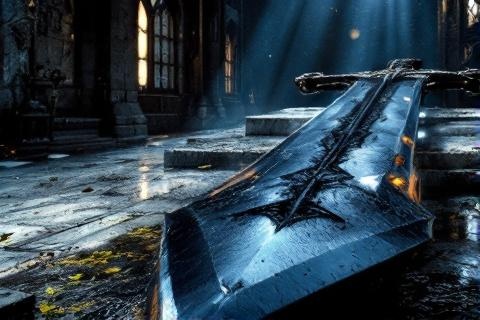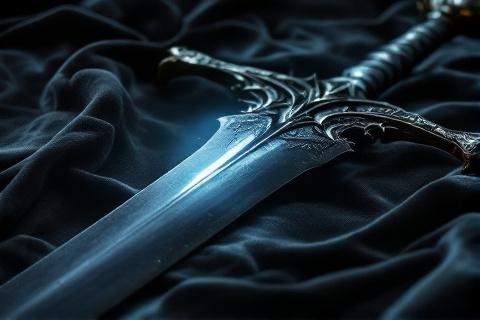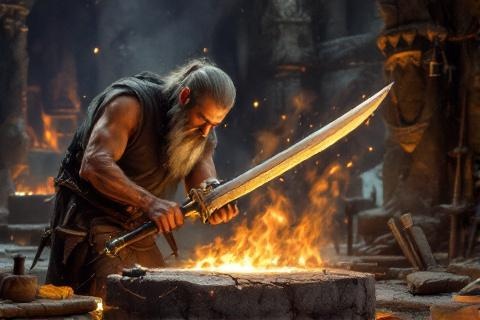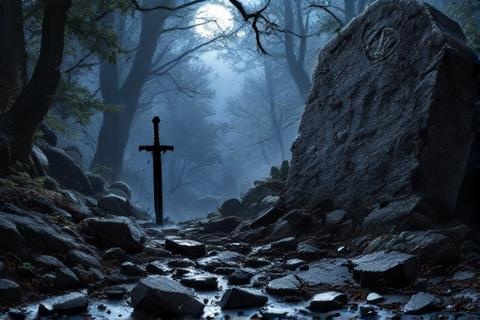
Anglachel
The Sentient Sword of the First Age
Origins in the Forge of Eöl

In the shadowy forests of Nan Elmoth during the First Age, Eöl
the Dark Elf, a masterful craftsman known for his exceptional metalwork, forged
the legendary sword Anglachel. His skills in smithing rivaled those of the
Noldor, and he worked in solitude within his dark realm.
The origin of Anglachel's metal was extraordinary, for it was crafted from
material that fell from the heavens themselves. This mysterious black metal was
unlike any found in Middle-earth, and its otherworldly
nature would contribute to the sword's unique properties.
During the forging process, Eöl poured not only his skill but also his very
essence into the blade. His dark nature, isolation, and complex personality
became intrinsically linked to the weapon's spirit. This fusion of craftsman and
creation would have far-reaching consequences for all who would later wield the
sword.
Physical Characteristics
Anglachel possessed a distinctive appearance that set it apart from all other
weapons of the First Age. Its black blade emitted a pale, cold fire that seemed
to capture and reflect light in an otherworldly manner, creating an unsettling
yet beautiful effect.
The sword's material originated from a meteoric iron that fell from the sky,
making it unique among the weapons of Middle-earth. This celestial metal granted
Anglachel properties that could not be replicated by traditional earthly
materials.
The blade's edge maintained an exceptional sharpness that few other weapons
could match. Its strength was legendary, capable of withstanding tremendous
force without suffering damage, marking it as one of the finest weapons ever
crafted in Beleriand.
Unlike the bright gleam of other elven-forged blades, Anglachel possessed a
distinct dark luster that seemed to absorb light rather than reflect it. This
unique characteristic gave the sword an ominous presence that could not be
ignored by those who beheld it.
The Nature of Sentience

Among Anglachel's most remarkable features was its possession of a conscious
spirit, making it more than merely a weapon. This awareness granted the sword a
level of sentience unique among the artifacts of the First Age.
The sword demonstrated an uncanny ability to affect the thoughts and actions of
those who wielded it. This influence manifested in subtle ways, often pushing
its bearers toward darker paths and more violent solutions to their challenges.
The darkness that dwelt within Anglachel's heart stemmed directly from Eöl's
influence during its creation. This shadow remained an integral part of the
blade's nature, persisting through all its years and affecting each of its
subsequent wielders.
Gift to Thingol

Eöl presented Anglachel to King Thingol of Doriath as payment
for his residence in Nan Elmoth, which lay within Thingol's realm. This tribute
demonstrated both Eöl's craftsmanship and his acknowledgment of Thingol's
sovereignty.
For many years, Anglachel remained within the armories of Menegroth, Thingol's
underground capital. The sword lay unused among the many treasures of Doriath,
its dark power dormant but not diminished.
Melian, the Maia queen of Doriath and wife
to Thingol, perceived the malice within the blade. Her foresight revealed that
Anglachel held a tragic destiny, though she did not fully disclose all that she
foresaw.
The sword remained in storage until Thingol granted it to Beleg Cúthalion, his
chief marchwarden. This decision would set in motion a chain of events that
would fulfill Melian's dark predictions.
In the Hands of Beleg
In the hands of Beleg Cúthalion, one of Doriath's greatest warriors, Anglachel
found a wielder worthy of its power. Though primarily known for his unmatched
skill with the bow, Beleg proved equally formidable with the black sword.
Beleg used Anglachel effectively in his role as Chief of the Marchwardens,
defending Doriath's borders against the growing threats from
Morgoth's forces. The sword's exceptional properties
proved valuable in countless encounters with orcs and other fell
creatures.
When Beleg undertook his fateful quest to find his friend Túrin
Turambar, he chose to carry Anglachel with him. This
decision would ultimately lead to tragic consequences, as the sword's dark
nature would play a crucial role in the events that followed.
Reforging and Renaming

Following Beleg's tragic death, the black sword was brought to
Nargothrond where skilled elven smiths reforged it. This
process marked a significant transformation in the weapon's history, though its
essential nature remained unchanged.
Upon its reforging, the sword received a new name: Gurthang, meaning 'Iron of
Death' in Sindarin. This name proved prophetic, as the blade would continue to
play a crucial role in dealing death throughout its remaining history.
The reforged blade took on a new appearance while maintaining its characteristic
black color and pale fire. The smiths of Nargothrond enhanced its already
formidable properties through their exceptional craftsmanship.
After its reforging, Gurthang became even more lethal than before. The
combination of its meteoric iron, Eöl's original craftsmanship, and the skill of
Nargothrond's smiths created a weapon of unparalleled power in Middle-earth.
Legacy and Fate

Anglachel, later Gurthang, stands as one of the rare instances of a speaking
weapon in all of Middle-earth's long history. Its ability to communicate
manifested most notably in its final moments, when it spoke to Túrin before his
death.
The sword's ultimate fate came when Túrin, upon learning the full tragedy of his
life, used it to end his own life. The blade broke beneath his weight, bringing
an end to both master and weapon in a final act of destiny.
The tale of Anglachel lived on in the songs and stories of the First Age,
becoming a legendary part of the tragic saga of Túrin Turambar. Bards and
loremasters would recount its dark deeds and memorable history for generations
to come.
The story of Anglachel serves as a powerful symbol of the interplay between fate
and free will in Tolkien's legendarium. Its influence on its wielders' actions
raises questions about destiny, choice, and the nature of evil in Middle-earth.
